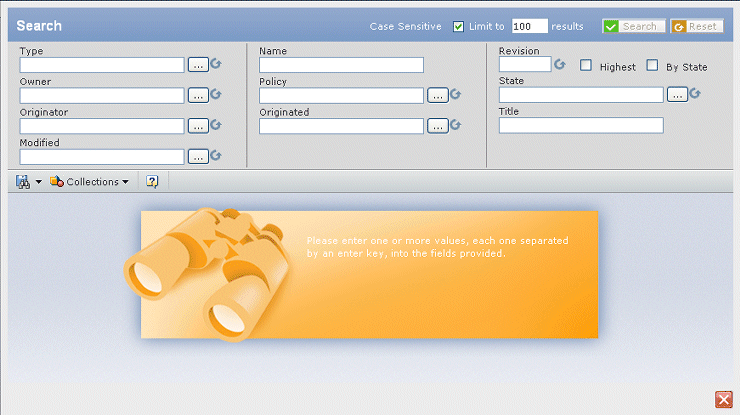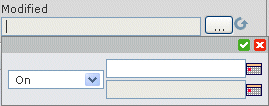Running a Search | |||||||
|
| ||||||
From the global toolbar, select
 > Search.
> Search.
Or
Select Add Existing from the page Actions menu or toolbar.
Or
Click
 next to the field where you need to search
for a value.
next to the field where you need to search
for a value.
You can click Reset at any time to clear all criteria fields.
Enter criteria as needed; you can use wildcards and enter multiple values (separated by commas) in any text field. Depending on your installation setup and where you selected to search, you may see additional or fewer fields:
Field How to Enter Value Type Click  and select the needed type if you need
to change the type shown in the text box. If you change the type, the
values available for the Policy field are updated to list only those
policies that support the selected type.
and select the needed type if you need
to change the type shown in the text box. If you change the type, the
values available for the Policy field are updated to list only those
policies that support the selected type.Owner Click  and select the name of the person who owns
the object.
and select the name of the person who owns
the object.
Originator Click  and select the name of the person who created
the object.
and select the name of the person who created
the object.Title Enter the title of the object (the title may be different from the name). Name Enter the name of the object. Policy See Step 3. Modified See Step 4. Revision Enter a specfiic revision level, or check the needed box:
- Highest. Searches for the most current revision of the object.
- By State. Searches for the current revision in the selected state.
State Click  to restrict the search to objects in a
specific lifecycle state. Select the needed state, then click
to restrict the search to objects in a
specific lifecycle state. Select the needed state, then click  .
.
Originated Click  to search for objects created within a
specified time frame. This field works the same as Modified.
to search for objects created within a
specified time frame. This field works the same as Modified.
To select a specific policy:
-
Click
 . Not all Types support more than one policy:
. Not all Types support more than one policy:

- Click the needed policy.
-
Click
 . If you change the policy,
the values available for the Current field are updated to list the states
in the selected policy.
. If you change the policy,
the values available for the Current field are updated to list the states
in the selected policy.
-
Click
To specify the date range to search for objects modified within a specific date range:
-
Click
 .
.

- Select a comparison operator from the drop-down list: = (equals), > (greater than), < (less than), or Between.
-
For all operators except Between, select a date from the first calendar
field.
For Between, select a date for both calendar fields.
-
Click
 .
.
-
Click
Use the Limit to text box to specify how many items should be shown in the search results. For example, if you limit the results to 50, the system will get only the first 50 items from the database that match your criteria. The maximum is by default 1000, but may vary depending on your installation setup.
Click Search. The bottom of the page displays the results that meet your criteria. See Search Results.
To save the search criteria, including the Type and Attribute selections:
-
Click
 > Save
As.
> Save
As.
- Enter a name for the search, or select an existing search to overwrite it.
- Click Done.
-
Click
To re-execute a saved search, click
 and click the name of
the search.
and click the name of
the search.
To add selected items to a collection, click Collections, and then click:
- Add to Clipboard Collection. Adds the items to your clipboard collection.
- New / Add to Collections. Opens the Select Collection dialog.
If you started the search using an Add Existing command or
 button, select the needed objects and click Submit.
button, select the needed objects and click Submit.